Hands On with USB Type C: Reversible USB Connectors
by Joshua Ho on September 11, 2014 9:00 AM EST- Posted in
- Smartphones
- Mobile
- Laptops
- Tablets
- USB-IF
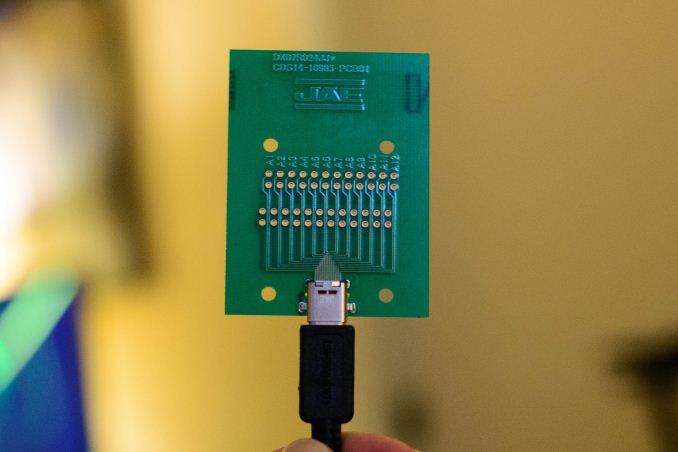
Today, the USB-IF brought me in to see the long-awaited USB Type C cables. We've written about this before, but for those that aren't familiar with this new USB spec, the USB Type C cable and USB 3.1 spec are designed with the future in mind. As a result, there are a lot of new features to talk about. We'll start with the USB 3.1 spec before we get into the Type C connector.
With USB 3.1, we see a few key improvements. Peak throughput goes to 10 Gbps from 5 Gbps, which translates to a peak of 1.25 GB/sec. In a demo of an early controller with two SSDs attached to the system I saw peak throughput of 833 MB/sec. As a side note, I also saw a demo of wireless USB connectivity from smartphone to laptop and laptop to smartphone, which was definitely pretty cool. Getting back to the USB 3.1 spec, USB Power Delivery 2.0 (PD) makes it possible for USB to supply up to 100 watts, and coexists with the BC 1.2 spec that is used in USB power adapters to charge phones so a single port would be able to provide power for both systems. In addition, USB PD 2.0 allows for power to go both ways without changing the direction of the cable, so a laptop would be able to send and receive power from the same port. Finally, USB Type-C extensions mean that it's possible to do all kinds of interesting applications over USB ports, such as sending audio and video data. It's even possible for a USB Type C port to send PCI-E data through the connection for use cases such as a two in one convertible tablet.
This opens up the possibility for a dock scenario where a single cable to the monitor can charge a laptop and also mirror the laptop's display onto the external monitor, and the external monitor would also be able to serve as a USB hub for a keyboard, mouse, headsets, flash drives, and other USB peripherals. While the laptop charging aspect and integrated USB hub in display wasn't demonstrated in the prototype I saw, everything else was fully working as shown in the photo above.
I was also able to get some photos of the cable and receptacle. Unfortunately it took flash to really show the detail in the connector but it definitely will be a great standard for all kinds of applications. While I'm sure that there will be differences in the final product, the reversible plug works just like expected and could be quickly inserted from behind the back. The USB-IF believes that this standard will show up in products shipping in 2015. It does seem that the connector is a bit less compact than microUSB, but the benefits outweigh this increase in size.


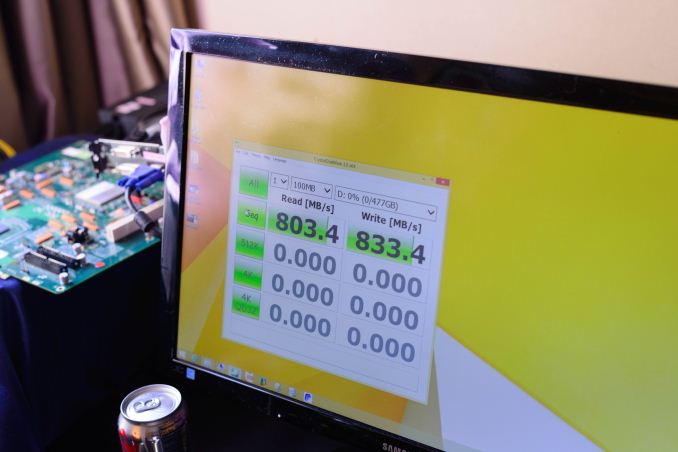
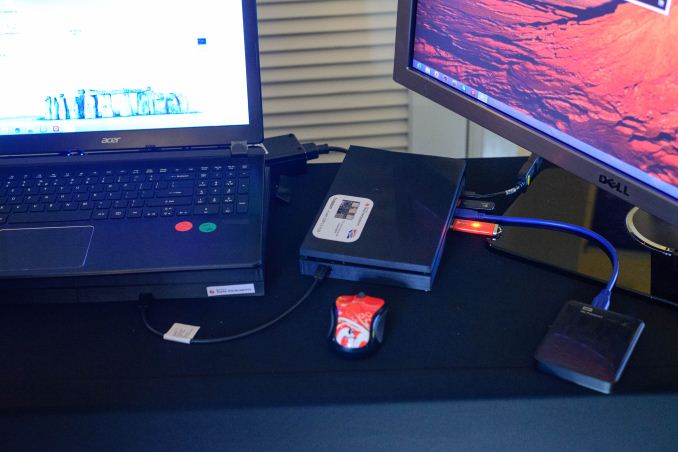
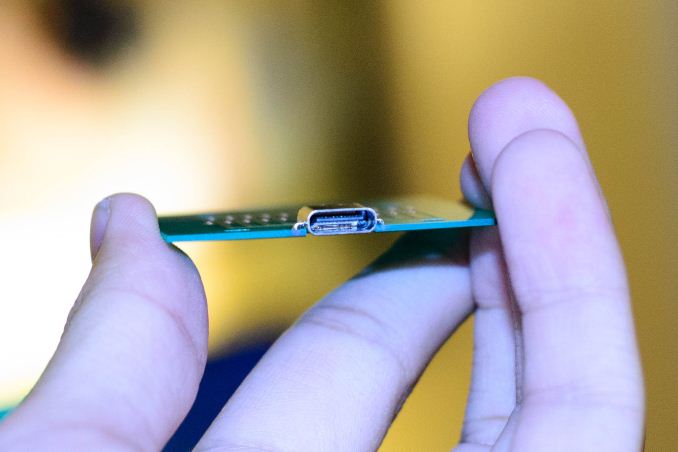
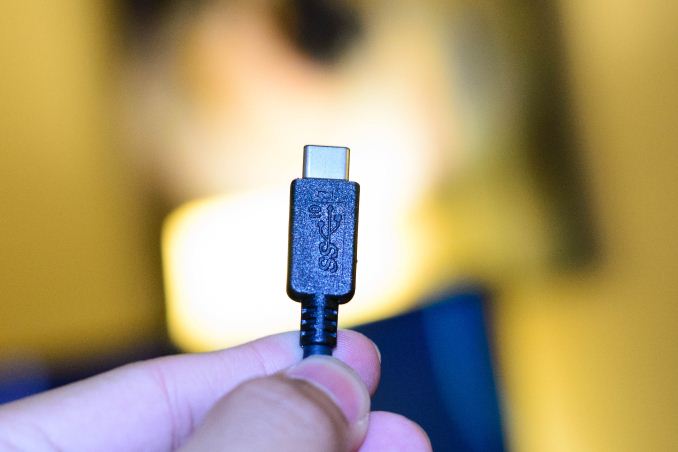
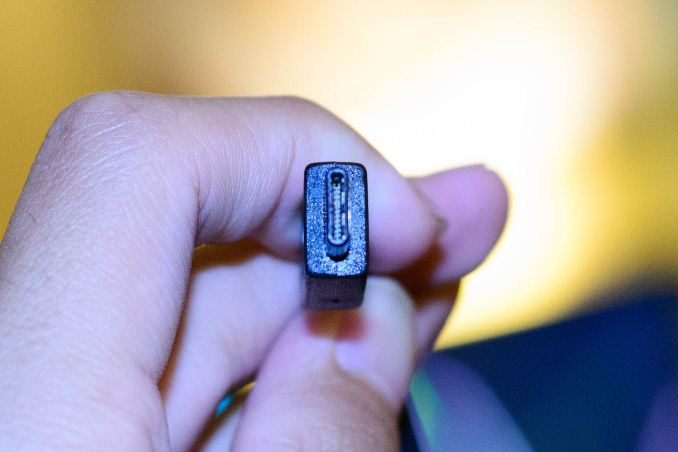








91 Comments
View All Comments
JoshHo - Thursday, September 11, 2014 - link
Fixed.nathanddrews - Thursday, September 11, 2014 - link
"Peak throughput goes from 10 Gbps from 5 Gbps, which translates to a peak of 1.25 GB/sec."I think you meant "goes to 10Gbps from 5Gbps" or "goes from 5Gbps to 10Gbps".
Very cool to see it taking shape.
silverblue - Thursday, September 11, 2014 - link
I'd love to see 1.25GB/s out of a USB cable, but I'd still be happy if we got 800MB to 1GB/s.inighthawki - Thursday, September 11, 2014 - link
I had to double take and read that about 3 times before it clicked for me. It says it's an improvement that totals 1.25GB/s, which is equivalent to saying "to 10 from 5" or "from 5 to 10"inighthawki - Thursday, September 11, 2014 - link
Sorry replied to the wrong post, this is meant to be in reply to ascend's post above.Pissedoffyouth - Thursday, September 11, 2014 - link
I use a USB3 hub which has a built in gigabit Ethernet port, which works great with my single port on the T100.I get pretty close to gigabit even with transferring but looking forward to next hybrids similar which have USB3.1 ports. A gigabit for Ethernet and 3 gigabits each for the other ports.
prasun - Thursday, September 11, 2014 - link
What transfer size was used in the test that got 800MBps?JoshHo - Thursday, September 11, 2014 - link
100MBPICman - Thursday, September 11, 2014 - link
I wonder how they get 100 watts from this connector (20 A at 5 V)? They must use several ground and power pins. It doesn't look like the PCB above would handle 100 watts.SirPerro - Thursday, September 11, 2014 - link
The spec supports that.Obviously the hardware must be ready to receive that and not get fried in the process.
(I guess it goes through some previous negotiation between both devices)